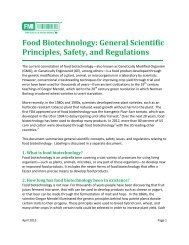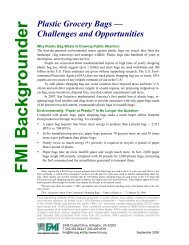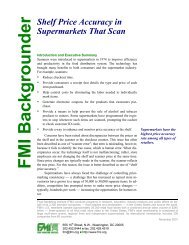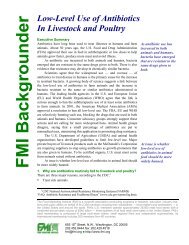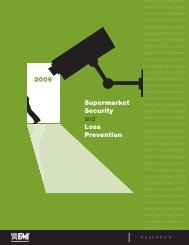Global Commerce Initiative EPC Roadmap - GlobalScorecard.net
Global Commerce Initiative EPC Roadmap - GlobalScorecard.net
Global Commerce Initiative EPC Roadmap - GlobalScorecard.net
Create successful ePaper yourself
Turn your PDF publications into a flip-book with our unique Google optimized e-Paper software.
<strong>Global</strong> <strong>Commerce</strong> <strong>Initiative</strong> <strong>EPC</strong> <strong>Roadmap</strong><br />
have less potential from deploying <strong>EPC</strong> than<br />
operations that are not as automated today.<br />
• Trials have been conducted both within the four<br />
walls of a company as well as collaboratively<br />
with trading partners. In general, manufacturers<br />
and retailers agree that the benefit potential<br />
increases significantly when trading partners<br />
adopt this technology across company operations.<br />
• Trials have been done at load carrier (logistics<br />
assets), pallet, case, and item levels. The results<br />
of these trials vary significantly in terms of benefit<br />
potential and overall return-on-investment<br />
opportunity.<br />
• Many of the leading adopters are still in the early<br />
stages of adoption and will use pilots as a way to<br />
validate the benefits and the costs.<br />
• Unit-level tagging can create significant benefits<br />
in terms of out-of-stock reductions and improvements<br />
to the overall consumer shopping experience.<br />
However, costs also increase significantly<br />
with unit tagging. Given current technology<br />
prices, item-level tagging may be reserved for<br />
high-cost and high-margin items until tag costs<br />
drop significantly.<br />
• There is a general perception that greater benefits<br />
accrue to the retailer than to the manufacturer<br />
with this initiative, especially if the manufacturers<br />
are asked to absorb the total tag costs. This<br />
perception is due in part to the belief that retailers<br />
will more easily generate scale through their<br />
system than their manufacturing partners.<br />
This final point is critical and should not be<br />
understated. Manufacturers have built considerable<br />
efficiencies over the years by creating supply chains<br />
based on minimising exceptions to improve<br />
efficiency and velocity. If only a portion of a<br />
manufacturer’s customers are using RFID tagging<br />
and exception handling must be introduced, this<br />
could lead to significantly higher supplier costs in<br />
the near term due to increased pick facings,<br />
repacking of pallets at the DC in order to tag<br />
individual cases, and so on.<br />
Additionally, much of the historical discussion on<br />
the cost of implementing RFID has revolved around<br />
the recurring tag costs to the manufacturer.<br />
Retailers, however, will need to make significant<br />
infrastructure investments to deploy this<br />
technology across their warehouses and stores,<br />
especially the considerable one-time capital costs in<br />
the roll out of RFID throughout their operations.<br />
There are also significant costs involved in the<br />
shelf-level implementation scenario.<br />
Both manufacturer and retail trading partners<br />
need to consider not only the magnitude of costs<br />
but also the timing and accounting impact of<br />
these costs. Both partners also need to engage<br />
in fact-based dialogues when discussing<br />
deployment options and benefit sharing to<br />
ensure a win-win scenario.<br />
“In Unilever we see RFID technology and the use of <strong>EPC</strong> impact<br />
our total supply chain. More than ever before, we need total<br />
alignment across our logistics, our customer interaction, and our<br />
technology to maximise the value of this breakthrough technology.<br />
That is the challenge we face, and we have taken up the gauntlet.”<br />
Nigel Bagley<br />
GCI Programme Manager, Unilever<br />
Business Applications Under Trial or Consideration<br />
In what areas are the RFID piloting pioneers<br />
focusing? Research indicates that while there are<br />
many ideas on how the <strong>EPC</strong> <strong>net</strong>work enables<br />
performance improvement, the leading adopters<br />
have converged on a common set of priority<br />
applications focusing primarily on implementations<br />
and piloting trials at the pallet and case levels.<br />
These applications include:<br />
• Shrink Reduction in the Supply Chain — Today<br />
retailers are tagging pallets, dollies, cases, and<br />
trays to track these units internally within their<br />
own supply chains. While source tagging is a<br />
natural complement to the infrastructure, shrink<br />
reduction trials nevertheless are driven by<br />
retailers’ desires to address current business<br />
problems.<br />
Industry research illustrates that retail shrink levels<br />
are approximately 2 percent of sales, which cost<br />
retailers some $32 billion in the US in 2001 and<br />
28 © Copyright November 2003, <strong>Global</strong> <strong>Commerce</strong> <strong>Initiative</strong>/IBM




